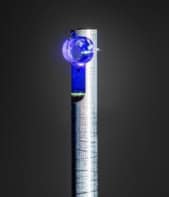The BaBar experiment at Stanford in the US has identified a new sub-atomic particle called the Ds(2317). The particle consists of a charm quark and a strange antiquark. Antimo Palano of the BaBar collaboration presented the result at the Stanford Linear Accelerator Center (SLAC) earlier this week.

Quarks and antiquarks come in six different ‘flavours’ and are held together in two and threes by gluons. Up and down quarks are the lightest and can be found in protons and neutrons. The strange, charm, bottom and top quarks are heavier and are not found in ordinary matter. However, they can be created in high-energy collisions at particle accelerators or in interactions between cosmic rays and atoms in the atmosphere.
The BaBar team used data from electron-positron collisions at the PEP-II asymmetric storage ring at SLAC. They plotted the number of candidate events for Ds particles against mass and observed a narrow peak in the distribution near 2.32 GeV (see figure).
Particles composed of a charm quark and a strange anti-quark have been detected before. However, the mass of the new meson – as a particle containing a quark and an antiquark is known – is lower than predicted by theoretical models. Moreover, the small width and the way in which it decays are also quite different from theory. This may mean that current models of charm mesons and quark potentials need to be modified. Alternatively, the particle could be in a novel, hitherto unseen, four-quark state. The team believes that these unexpected findings could provide insights into the force that binds quarks, and indeed gluons, together.



